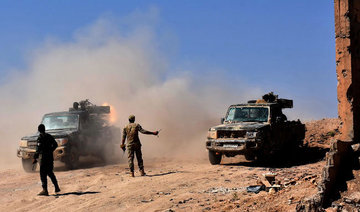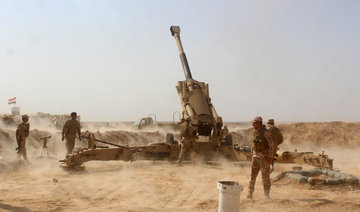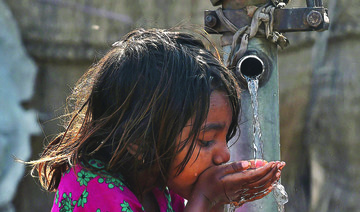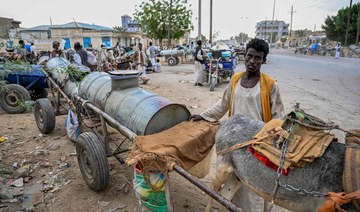ALEPPO: Flicking through before-and-after photos of Aleppo’s Umayyad mosque on his phone, the city’s Mufti Mahmoud Akkam said he initially wanted the celebrated landmark to be restored by fellow Syrians.
But when Ramzan Kadyrov, the strongman chief of Russia’s Chechnya region, offered to repair the damage that the ancient mosque sustained in ferocious clashes four years ago, Akkam felt he could not say no.
“He was very persistent,” Akkam said, “and since we are of the same religion and he understands us, we accepted.”
Kadyrov is a fierce loyalist of Russian President Vladimir Putin, but has also sought to present himself as an influential figure for Muslims worldwide.
A fund named after his father Akhmat has already transferred the estimated $14 million needed to fund the mosque’s restorations.
If it is not enough, “they will transfer more,” Akkam told journalists on a tightly controlled tour of Aleppo organized by Russia’s military to tout the city’s resurgence.
Syria’s second city was battered by four years of fighting between fighters in the east and regime forces in the west, until an evacuation deal at the end of 2016 brought it under regime control.
One of the bloodiest frontlines was Aleppo’s Old City, a UNESCO-listed world heritage site featuring the ancient covered market, centuries-old citadel, and famous Umayyad Mosque.
Clashes in April 2013 reduced the mosque’s minaret, which dates back to the 11th century, to an unrecognizable pile of blocks.
Russia has been a decades-long ally of Damascus and stuck by its side when the uprising against President Bashar Assad broke out in 2011, before devolving into a civil war that has killed over 330,000 people.
In September 2015, Moscow began carrying out airstrikes that have allowed Syrian troops to retake swathes of territory — including Aleppo.
Now that it is back under regime control, Russia appears keen to help rebuild it.
Aleppo’s skyline features massive posters of Assad against a backdrop of the ancient citadel.
The cacophony of honking and buzz of shoppers in some neighborhoods sounds like that of any metropolis, but much of the city’s east still lies in silent ruin.
Analysts say Syria’s financial institutions are not in a position to fund reconstruction and nations that have called for Assad’s ouster are unlikely to help.
Allies like Russia and Iran have stepped in to fill the void.
Syria signed a memorandum of understanding on Tuesday with Tehran for the provision of five gas units to help generate electricity and restore power to Aleppo.
And on Wednesday, Moscow said it will send some 4,000 tons of building materials and construction equipment to Syria to help “rebuild vital infrastructure for settlements” freed from fighters.
The delivery — including 2,000 tons of metal water pipes and hundreds of kilometers of high-voltage cables — was being transported by train to a port in southern Russia for onward shipment to Syria.
Asked whether the West was helping rebuild Aleppo, Deputy Gov. Faris Faris said Europe “only gave us militants to kill Syrian people.”
“We will have to rebuild ourselves, with government help. Without European help,” he said.
And Akkam said UNESCO had not done enough for the city’s heritage whereas Chechnya’s Kadyrov “extended his help at a very difficult time.”
The pro-Putin leader has helped rebuild Russia’s largest mosque.
Officials also appeared keen to brandish Moscow’s help in restoring Aleppo’s Al-Furqan school and providing Syrian students there with back-to-school packages.
“Russia has been here for a long time,” said Deputy Provincial Gov. Hamid Kino.
Russian forces were providing security for aid convoys and helping transport families displaced from Aleppo’s outskirts back into their battered hometowns, he said.
“Every day people come back to those towns. Some have their own cars, but for others, we find buses while the Russians bring Kamaz trucks for people’s belongings,” Kino said.
Around 3,500 people were bussed back in the past month-and-a-half to towns recaptured by Syrian troops, said Gen. Igor Yemelyanov, who heads the Russian Center for Reconciliation in Syria.
And within the city, Moscow has dispatched its military police to prevent looting and maintain order.
Most are from Chechnya, though some are from other majority-Muslim areas in the Russian Caucasus, said one Chechen officer.
“We have the same faith,” which helps understanding the locals, he said.
Driving new Russian Tigr all-terrain infantry vehicles, the forces wear red berets and arm bands branded with the name “military police” in Russian.
“When we were here in January there was a lot of looting. Now it’s stopped,” he said.
After helping retake Aleppo, Russia seeks to rebuild it
After helping retake Aleppo, Russia seeks to rebuild it
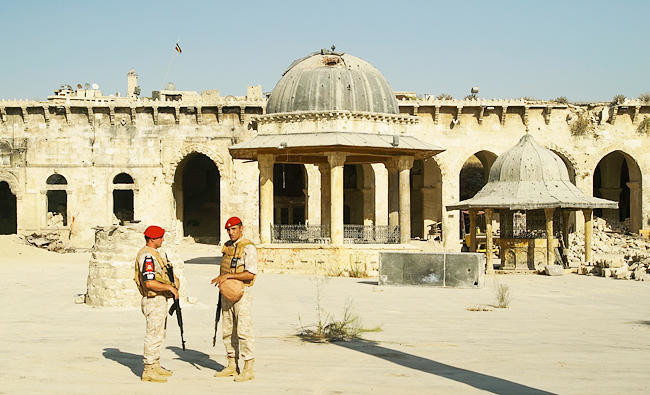
Water crisis batters war-torn Sudan as temperatures soar

- The country at large, despite its many water sources including the mighty Nile River, is no stranger to water scarcity
- This summer, the mercury is expected to continue rising until the rainy season hits in August
PORT SUDAN, Sudan: War, climate change and man-made shortages have brought Sudan — a nation already facing a litany of horrors — to the shores of a water crisis.
“Since the war began, two of my children have walked 14 kilometers (nine miles) every day to get water for the family,” Issa, a father of seven, said from North Darfur state.
In the blistering sun, as temperatures climb past 40 degrees Celsius (104 degrees Fahrenheit), Issa’s family — along with 65,000 other residents of the Sortoni displacement camp — suffer the weight of the war between Sudan’s army and the paramilitary Rapid Support Forces (RSF).
When the first shots rang out more than a year ago, most foreign aid groups — including the one operating Sortoni’s local water station — could no longer operate. Residents were left to fend for themselves.
The country at large, despite its many water sources including the mighty Nile River, is no stranger to water scarcity.
Even before the war, a quarter of the population had to walk more than 50 minutes to fetch water, according to the United Nations.
Now, from the western deserts of Darfur, through the fertile Nile Valley and all the way to the Red Sea coast, a water crisis has hit 48 million war-weary Sudanese who the US ambassador to the United Nations on Friday said are already facing “the largest humanitarian crisis on the face of the planet.”
Around 110 kilometers east of Sortoni, deadly clashes in North Darfur’s capital of El-Fasher, besieged by RSF, threaten water access for more than 800,000 civilians.
Medical charity Doctors Without Borders (MSF) on Friday said fighting in El-Fasher had killed at least 226.
Just outside the city, fighting over the Golo water reservoir “risks cutting off safe and adequate water for about 270,000 people,” the UN children’s agency UNICEF has warned.
Access to water and other scarce resources has long been a source of conflict in Sudan.
The UN Security Council on Thursday demanded that the siege of El-Fasher end.
If it goes on, hundreds of thousands more people who rely on the area’s groundwater will go without.
“The water is there, but it’s more than 60 meters (66 yards) deep, deeper than a hand-pump can go,” according to a European diplomat with years of experience in Sudan’s water sector.
“If the RSF doesn’t allow fuel to go in, the water stations will stop working,” he said, requesting anonymity because the diplomat was not authorized to speak to media.
“For a large part of the population, there will simply be no water.”
Already in the nearby village of Shaqra, where 40,000 people have sought shelter, “people stand in lines 300 meters long to get drinking water,” said Adam Rijal, spokesperson for the civilian-led General Coordination for Displaced Persons and Refugees in Darfur.
In photos he sent to AFP, some women and children can be seen huddled under the shade of lonely acacia trees, while most swelter in the blazing sun, waiting their turn.
Sudan is hard-hit by climate change, and “you see it most clearly in the increase in temperature and rainfall intensity,” the diplomat said.
This summer, the mercury is expected to continue rising until the rainy season hits in August, bringing with it torrential floods that kill dozens every year.
The capital Khartoum sits at the legendary meeting point of the Blue Nile and White Nile rivers — yet its people are parched.
The Soba water station, which supplies water to much of the capital, “has been out of service since the war began,” said a volunteer from the local resistance committee, one of hundreds of grassroots groups coordinating wartime aid.
People have since been buying untreated “water off of animal-drawn carts, which they can hardly afford and exposes them to diseases,” he said, requesting anonymity for fear of reprisal.
Entire neighborhoods of Khartoum North “have gone without drinking water for a year,” another local volunteer said, requesting to be identified only by his first name, Salah.
“People wanted to stay in their homes, even through the fighting, but they couldn’t last without water,” Salah said.
Hundreds of thousands have fled the fighting eastward, many to the de facto capital of Port Sudan on the Red Sea — itself facing a “huge water issue” that will only get “worse in the summer months,” resident Al-Sadek Hussein worries.
The city depends on only one inadequate reservoir for its water supply.
Here, too, citizens rely on horse- and donkey-drawn carts to deliver water, using “tools that need to be monitored and controlled to prevent contamination,” public health expert Taha Taher said.
“But with all the displacement, of course this doesn’t happen,” he said.
Between April 2023 and March 2024, the health ministry recorded nearly 11,000 cases of cholera — a disease endemic to Sudan, “but not like this” when it has become “year-round,” the European diplomat said.
The outbreak comes with the majority of Sudan’s hospitals shut down and the United States warning on Friday that a famine of historic global proportions could unfold without urgent action.
“Health care has collapsed, people are drinking dirty water, they are hungry and will get hungrier, which will kill many, many more,” the diplomat said.
UAE, Iran discuss bilateral relations

DUBAI: The United Arab Emirats Minister of Foreign Affairs, Sheikh Abdullah bin Zayed, had a phone conversation on Saturday with Iran's acting Minister of Foreign Affairs, Ali Bagheri Kani, to discuss the bilateral relations between the two countries.
During the call, they exchanged Eid Al-Adha greetings and explored ways to enhance cooperation that would serve the mutual interests of their countries and peoples, contributing to regional security and stability.
They also reviewed several issues of common interest, as well as recent developments in both regional and international arenas.
Two explosions near vessel off Yemen’s coast, UK maritime office says

- Houthi militants, who are backed by Iran, have been targeting vessels off the Yemen’s coast
CAIRO: The United Kingdom Maritime Trade Operations (UKMTO) said on Sunday a vessel 40 nautical miles south of Al-Mukha in Yemen had reported two explosions nearby, adding that the vessel and its crew were safe and proceeding to their next port of call.
Authorities are investigating, UKMTO said.
UKMTO WARNING INCIDENT 087 ATTACK UPDATE 001https://t.co/fX3hWupi7g#MaritimeSecurity #MarSec pic.twitter.com/tOQXLZoQ9w
— United Kingdom Maritime Trade Operations (UKMTO) (@UK_MTO) June 16, 2024
Houthi militants, who are backed by Iran, have been targeting vessels off the Yemen’s coast in what they said is a show of solidarity with the Palestinians being killed in Israel’s war on Gaza.
Iran rebukes G7 statement over its nuclear program escalation

- Tehran’s foreign ministry calls on G7 to distance itself from ‘destructive policies of the past’
- Iran is now enriching uranium to up to 60 percent purity close to the 90 percent weapons grade
DUBAI: Iran called upon the Group of Seven on Sunday to distance itself from “destructive policies of the past,” the Iranian Foreign Ministry spokesperson Nasser Kanaani said, referring to a G7 statement condemning Iran’s recent nuclear program escalation.
On Friday, the G7 warned Iran against advancing its nuclear enrichment program and said they would be ready to enforce new measures if Tehran were to transfer ballistic missiles to Russia.
“Any attempt to link the war in Ukraine to the bilateral cooperation between Iran and Russia is an act with only biased political goals,” Kanaani said, adding that some countries are “resorting to false claims to continue sanctions” against Iran.
Last week, the UN nuclear watchdog’s 35-nation Board of Governors passed a resolution calling on Iran to step up cooperation with the watchdog and reverse its recent barring of inspectors.
Iran responded by rapidly installing extra uranium-enriching centrifuges at its Fordow site and begun setting up others, according to a International Atomic Energy Agency (IAEA) report.
Kanaani added Tehran would continue its “constructive interaction and technical cooperation” with the IAEA, but called its resolution “politically biased.”
Iran is now enriching uranium to up to 60 percent purity, close to the 90 percent of weapons grade, and has enough material enriched to that level, if enriched further, for three nuclear weapons, according to an IAEA yardstick.
Israeli military announces ‘tactical pause’ in attempt to increase flow of aid into hard-hit Gaza

- The pause is aimed at allowing aid trucks to reach the Israel-controlled Kerem Shalom crossing
JERUSALEM: The Israeli military on Sunday announced a “tactical pause” in its offensive in the southern Gaza Strip to allow the deliveries of increased quantities of humanitarian aid.
The army said the pause would begin in the Rafah area at 8 a.m. (0500 GMT, 1 a.m. eastern) and remain in effect until 7 p.m. (1600 GMT, noon eastern). It said the pauses would take place every day until further notice.
The pause is aimed at allowing aid trucks to reach the nearby Israel-controlled Kerem Shalom crossing, the main entry point for incoming aid, and travel safely to the Salah a-Din highway, a main north-south road, to deliver supplies to other parts of Gaza, the military said. It said the pause was being coordinated with the UN and international aid agencies.
The crossing has suffered from a bottleneck since Israeli ground troops moved into Rafah in early May.
Israel’s eight-month military offensive against the Hamas militant group has plunged Gaza into a humanitarian crisis, with the UN reporting widespread hunger and hundreds of thousands of people on the brink of famine. The international community has urged Israel to do more to ease the crunch.
From May 6 until June 6, the UN received an average of 68 trucks of aid a day, according to figures from the UN humanitarian office, known as OCHA. That was down from 168 a day in April and far below the 500 trucks a day that aid groups say are needed.
The flow of aid in southern Gaza declined just as the humanitarian need grew. More than 1 million Palestinians, many of whom had already been displaced, fled Rafah after the invasion, crowding into other parts of southern and central Gaza. Most now languish in ramshackle tent camps, using trenches as latrines, with open sewage in the streets.
COGAT, the Israeli military body that oversees aid distribution in Gaza, says there are no restrictions on the entry of trucks. It says more than 8,600 trucks of all kinds, both aid and commercial, entered Gaza from all crossings from May 2 to June 13, an average of 201 a day. But much of that aid has piled up at the crossings and not reached its final destination.
A spokesman for COGAT, Shimon Freedman, said it was the UN’s fault that its cargos stacked up on the Gaza side of Kerem Shalom. He said the agencies have “fundamental logistical problems that they have not fixed,” especially a lack of trucks.
The UN denies such allegations. It says the fighting between Israel and Hamas often makes it too dangerous for UN trucks inside Gaza to travel to Kerem Shalom, which is right next to Israel’s border.
It also says the pace of deliveries has been slowed because the Israeli military must authorize drivers to travel to the site, a system Israel says was designed for the drivers’ safety. Due to a lack of security, aid trucks in some cases have also been looted by crowds as they moved along Gaza’s roads.
The new arrangement aims to reduce the need for coordinating deliveries by providing an 11-hour uninterrupted window each day for trucks to move in and out of the crossing.
It was not immediately clear whether the army would provide security to protect the aid trucks as they move along the highway.



